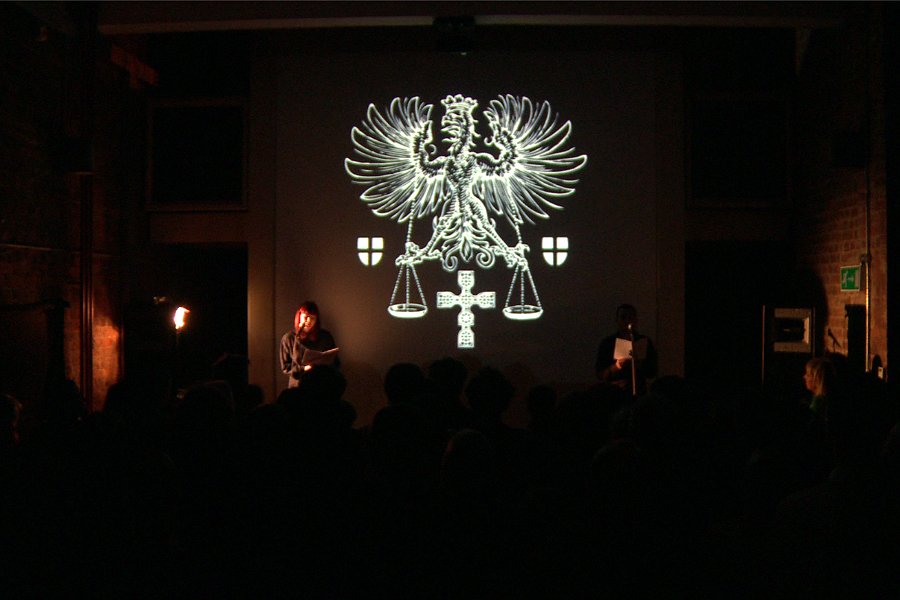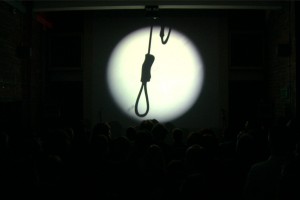Unsettle @ Metal, Liverpool Biennial 2012

Jon Davies finds HIVE in scintillating form in a recreation of the Pendle witch trials at Metal…
Whenever the HIVE team are involved in a large scale audiovisual project in Liverpool you know there’s going to be something special happening, at the very least a real subversion from the rest of the Biennial programming, and Unsettle did not disappoint.
Having found much of the Biennial a little tepid and safe, Unsettle was the type of event that didn’t in any way feel steeped in accommodation. The audience was in fact ‘welcomed’ to Metal by four hoodied ushers in the blistering cold, then herded into a small dimly lit gallery with hardly room to breathe.
Unsettle provides a series of meditations on the Pendle Witch Trials of 1612 based on the collective memory of the trial, the procession and the hanging and its effect on Pendle. Instead of providing a blow-by-blow narrative of the events, specific themes were singled out for further exploration. Starting with a disquieting wandering eye over the misty landscape of Pendle, cellist Jonathan Aasgaard provided an elegiac improvisation that wandered as sullenly as the visuals depicting a place in England that seemed to have been left untouched since the 15th century.
The audience however had been left in a false sense of security, as events took a darker turn. A pulsating crest shadowed two speakers reciting the recorded events of the Witch Trials, overlapping information whilst the crest behind begins to draw attention through its violent convulsions. As the recital concluded the ushers forced handouts towards members of the audience, implicitly accusing them of witchcraft enablement. Nooses are then prepared onscreen amongst other daily chores, signifying the strange place witchcraft and superstition held in society, as if it were just another part of living in Pendle.
Whilst these activities were merely slightly discomforting, Unsettle came into its own with sound artist Rob Strachan providing a devastating reworking of the Black Dyke Band’s penetrative brass marches. Onscreen came a terrifying work of judicial symbolism shuddering at the onslaught of layered rumblings from the band, most memorably a clock ticking towards execution intersected by a scorning Jesus. A girl speaking to us close-up about her ‘experience’ of the witch trials gave temporary reprieve to the audience.

Removed from the pomp of Justice, her performance reminded us of the reality and fear instilled by witch-hunts, whilst portraying the innocence of a pre-enlightened society, or perhaps a parallel to how easily society can be lead into false belief. Entitled Procession, the juxtaposition between the innocent child and the portrait following was perhaps the most devastating part of Unsettle.
All senses were overloaded slowly and methodically, dark rumblings of trudged up gravel and a growling dog accompanied by a constellation of lamps intermittently revealed by a strobe flash hinted at both dread and feverish celebration. Added anxiety was pushed over the edge with the presentation of the noose, as well as full on aural synthetic batterings accompanied by more intense strobing until we were simply submitted to almost detention camp style sensory torture. One may be inclined to say it was easy to simply have noise and strobe as the peak of the piece, but by then the audience was completely drawn into the narrative that to suck them back out in such a minimalistic way felt most physically appropriate.
The piece concluded in a symmetrical fashion with Jonathan Aasgaard performing once more alongside an inspection of soil mounds, where comparisons to the opening scene are inevitably drawn. It’s almost as if the Witch Trials have sucked the life out of both the landscape of Pendle and the audience, and all that’s left is dry ground, neatly aligned like graves. The conclusion is simply 11 marks across the screen, remembering those who were tried and murdered in the last Witch Trials in Britain.
Its poignant ending completed an exhilarating piece of work, which thanks to its non-narrative presentation allowed for the work to act like a symposium of moving portraits, in some ways reminiscent of iconography of the Passion. Except without the redemption.





